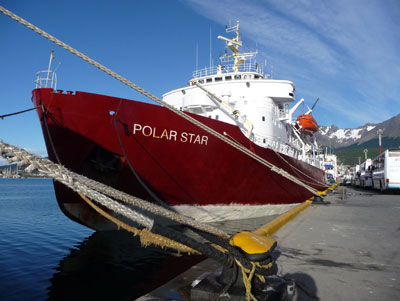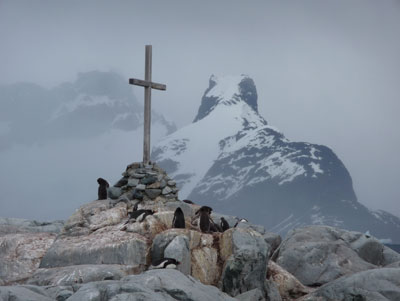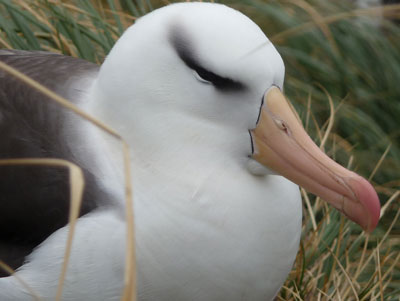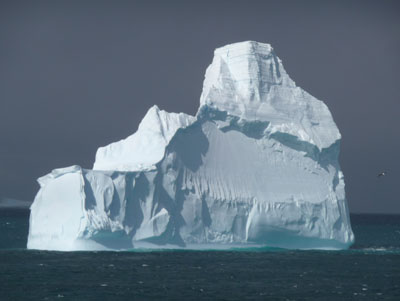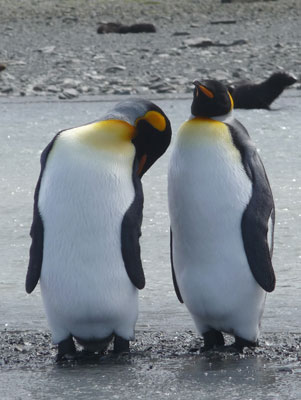Awed by the Antarctic on a month-long cruise
by Dennis Sherwood, Gig Harbor, WA
Frigid water sprayed over us as our Zodiac plowed through choppy seas toward Livingston Island in the Antarctic South Shetlands. With every lurch of the small boat, icy torrents splashed the face of our intrepid driver, rivulets streaming from his salt-and-pepper beard, evoking a drenched schnauzer. Shielded by waterproof clothing, we turned from the waves and laughed aloud at our predicament, giddy with adventure!
The tour
As we made our final landing on a 27-day, December’08-January ’09 tour of the South Atlantic, we felt fortunate to have participated with Cheesemans’ Ecology Safaris (Saratoga, CA; 800/527-5330, www.cheesemans.com) on their yearly expedition to the Falkland Islands, South Georgia and the great White Continent, Antarctica.
Our ship, the Polar Star — a Swedish icebreaker converted for the tourism trade — handily accommodated 93 passengers plus Cheesemans’ group of enthusiastic naturalists and Zodiac drivers as well as the ship’s operations crew, a Polish captain and a Philippine housekeeping staff.
We’d purposely chosen to travel with this smaller group to maximize our time ashore. By agreement among members of the International Association of Antarctic Tour Operators (IAATO), no more than 100 visitors are allowed to land at once, not only to reduce the impact on the wildlife but to provide a quality experience.
Larger groups must exchange visitors at landings, limiting shore time for each individual. Ships with more than 500 passengers cannot land at all.
Cheesemans offers one of the most extensive trips available, including nearly four weeks of wildlife viewing, both on shore and at sea. Our Zodiac landings included four privately owned islands in the Falklands (one of which was the seldom-visited Steeple Jason with its colony of a half-million black-browed albatrosses) plus a week exploring the east coast of South Georgia, a day in the South Orkneys and another week on the Weddell Sea and Antarctic Peninsula — altogether navigating nearly 4,000 nautical miles.
Wondrous wildlife
It was a wildlife viewer’s and photographer’s dream trip to a landscape of the imagination — mesmerizing clouds and light; fantastical icebergs; glaciered mountains plunging to the sea; eight species of whales and dolphins; seven species of seals, and eight species of penguins, including the iconic emperor penguin. Other avian species included six types of albatross and the stark-white snow petrel, perhaps the most southerly nesting bird in the world. Our senses were overwhelmed.
Stepping into the surf at Livingston, a disembarkation typical of the rubber-booted “wet” landings we made from the Zodiac shuttles between ship and exotic shores, we quickly moved up to drier ground. Helpful staff was always available to assist with these sometimes-tricky transitions.
On the shore sprawled a noisy wallow of molting elephant seals, belching and flatulent, and, just beyond, a raucous colony of nesting chinstrap penguins with their always-ravenous offspring. After a 5-minute walk along the rocky beach, we encountered the territory of a mellower gentoo penguin colony.
Predatory skuas lurked about, eager to snatch a sickly or unguarded chick. How lucky we felt having the opportunity to witness and marvel at these real-life dramas as they unfolded.
We wandered half a mile farther around the cove toward a glacier that cascaded to the tide line, stopping at an outcrop of rocks that contained fossils of ferns and petrified wood, signs of a much different climate long ago.
The entire trip had been like that, one startling surprise after another for which mere words and photography seemed inadequate. As a fellow passenger exclaimed, “No camera is large enough to capture the beauty of this place.”
The Weddell Sea
The previous week we had sailed into the edge of the Weddell Sea, a vast area about four times the size of Spain, searching for emperor penguins nesting on ice floes, though their nesting season had ended months before. No emperors!
Thankful for our thick-hulled icebreaker, we encountered, instead, massive tabular bergs that had broken away and drifted from continental ice shelves farther south, some of them over two miles in length with flat “table” tops taller than our 8-story ship.
These immense islands of ice will persist for years, slowly melting and spiraling away from the continent as they fracture into hundreds of smaller bergs of sizes that, in the Northern Atlantic, would have easily sunk the Titanic.
We circumnavigated Snow Hill Island through open water at nearly 65 degrees south — a feat not usually possible due to heavy ice in the Weddell Sea and enabled, perhaps, by global warming — and eventually anchored off Devil’s Island.
At 1 a.m. an announcement over the ship’s intercom informed us that an emperor penguin had been spotted on an ice floe off the port side. Wakened passengers eagerly rushed outside to the decks to view this much-sought species in the dim light of an Antarctic summer’s night. With early-morning wake-up calls and late-night wildlife viewing, this was not your typical pleasure cruise.
South Georgia
The week before that, we had tied up at the small dock in Grytviken, the official government settlement for British-administered South Georgia Island. Ernest Henry Shackleton is buried in the cemetery there, which is a must-see tribute to the famous Antarctic explorer who managed to safely rescue his entire crew when their wooden ship, the Endurance, was crushed by ice in the Weddell Sea in 1915.
His profound accomplishment prompted one biographer to write in praise, “When…all hope is gone, get down on your hands and knees and pray for Shackleton.”
We stood at his memorial in a drizzling rain while the staff historian spoke a fitting eulogy, then toasted with a sip of whiskey to “The Boss,” mindful of the tradition of spilling a little onto his grave.
A walk through this one-time whaling station where tens of thousands of the leviathans were slaughtered and rendered for their blubber is sobering. A well-organized museum highlights the history of exploration and whaling in the Southern Ocean as well as the diversity of local wildlife.
At several landing sites on South Georgia we spent many hours ashore free to wander, with a few cautionary caveats, past throngs of fur seals and colonies of over 100,000 penguins. A 15-foot approach rule was advised throughout the Southern Ocean region to reduce man’s impact on wildlife behavior. Photographic opportunities were awesome.
What to expect
Although requiring a significant amount of time and a substantial financial commitment, this was an incredible adventure. The passengers, ranging in age from upper 20s to mid-70s, invariably were active and adventurous.
There was a staff doctor on board and a small infirmary, but it was a long way to a hospital, so Cheesemans required passengers to obtain medical evacuation insurance. Even so, the nearest landing strip could be two to three days away by ship.
For most participants, the prospect of having amazing wildlife photography opportunities was a prime motivation. During days at sea, informative lectures provided background on the behavior and identification of birds and other wildlife as well as on area geology and the history of exploration, plus tips on photography and videography. A staff artist offered popular classes in wildlife drawing.
What about weather? The coldest temperature we experienced was 32oF on a couple of mornings, with averages in the upper 30s to mid-40s. However, chilling wind was common, especially at sea, significantly lowering the effective temperature. The peninsula is considered the banana belt of Antarctica, and the farthest south we went was over 90 miles from the Antarctic Circle.
Our weather palette variously consisted of clouds of every description, brilliant sunshine, cold sleet, snowfall, sparkling blue skies and dense fog. Layers of appropriate clothing plus gloves and warm hats were imperative.
The details
We flew through Houston to Buenos Aires on Continental Airlines ($1,400 round trip from the Pacific Northwest) at the end of December, summer in Antarctica, landing at the international Aeropuerto Ezeiza (EZE). We then traveled 40 minutes by taxi to the domestic airport, Aeroparque (AEP), for our connecting flight to the city of Ushuaia with Aerolíneas Argentinas ($730).
At Cheesemans’ suggestion, we used the taxi service Manuel Tienda León, located inside the EZE terminal, to arrange our transportation to AEP ($40 for a party of four).
The cost for the December ’09-January ’10 offering starts at $14,495 per person, including transfers to and from the Ushuaia airport, all meals aboard the ship, one night’s accommodation and breakfast in Ushuaia before the cruise and a half-day bus and walking tour of nearby Tierra del Fuego National Park.
Cheesemans provided a thorough list of what to bring, e.g., waterproof clothing and a dry bag for camera equipment. Rubber boots for wet landings were available free of charge. Dress on board the ship was casual.
Our shipboard accommodations were modern. The cabins were cleaned daily by a courteous staff. Personal laundry service was available for an additional fee.
Although this was not intended to be a luxury cruise, the ship’s food selection and service was very good. Breakfast and lunch were cafeteria style, while dinner was a table-service affair with a choice of meat, fish or vegetarian entrée.
The Polar Star’s bridge was open to passengers 24/7 — a great place to study navigational charts, scan GPS and radar screens and watch for wildlife.
With the Southern Ocean’s well-deserved reputation for stormy seas, we wore doctor-prescribed scopolamine patches as a prophylactic against seasickness.
More than 30 companies offer Antarctic tours from Ushuaia. Most cross the stormy Drake Passage to and from the peninsula on shorter, less-expensive 7- to 10-day cruises. A little research should help you decide which type of trip will meet your personal budget and interests. The website www.iaato.org provides links to their member tour operators.


